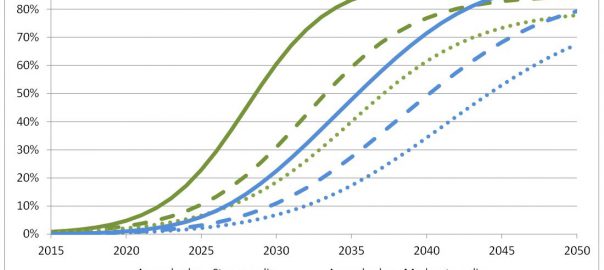Various policy driven scenarios show electric vehicles gaining market share over the next few decades but with the turnover of the vehicle stock taking longer.

I recently argued that BP’s projections showing almost no take-up of plug-in vehicles[1] by 2035 was unrealistic in view of several convergent trends. There is increasing pressure to reduce CO2 emissions, there is large and growing concern about urban air quality, and electric vehicles are likely to prove attractive to consumers in many respects. In line with these drivers, sales are growing very quickly and many new models are coming on line, while battery technology is improving rapidly, with costs falling sharply and energy density rising.
However while these factors suggest that electric vehicles will gain substantial market share it does not say how much how soon[2]. So how fast might the market for plug-in vehicles grow if policy drivers are strong and matched by favourable economics? Here I consider how quickly electric vehicles could gain market share on that sort of optimistic view.
Market share gains for new technologies
The transition to electric vehicles is in its early stages, so extrapolating historical trends offers only limited guidance. Similarly, highly detailed modelling may not offer robust insights, because too many assumptions are required. Instead it seems appropriate to look at some broad indicators.
A good starting point is to look at adoption other new technologies. The chart below shows the rates of penetration of new technologies in the USA over the 20th and early 21stcenturies. It shows variants on a characteristic s-curve shape, with most technologies reaching eventual penetrations of 80-100%. The typical time to reach about 80% penetration following the first 1% or so of deployment (about where plug-in vehicles are now) is around 20-30 years, although some modern highly scalable technologies have become nearly ubiquitous faster than this, and other technologies have taken as long as fifty years or so to reach high penetration.
For example, cars themselves experienced rapid growth between around 1910 and 1930, reaching 60% of households, before experiencing hiatus and decline during the Great Depression and Second World War, before growing steadily again through the to the second half of the 20th Century.
Read more: The Energy Collective
